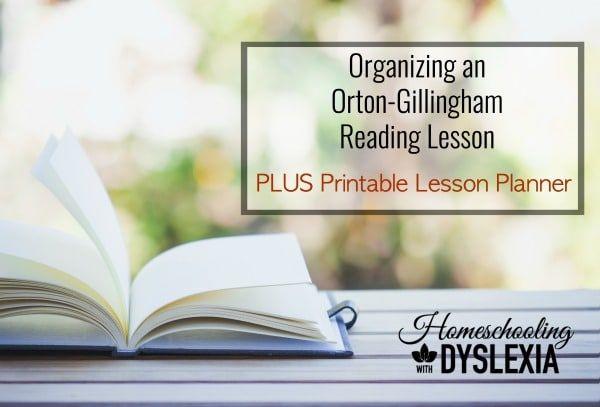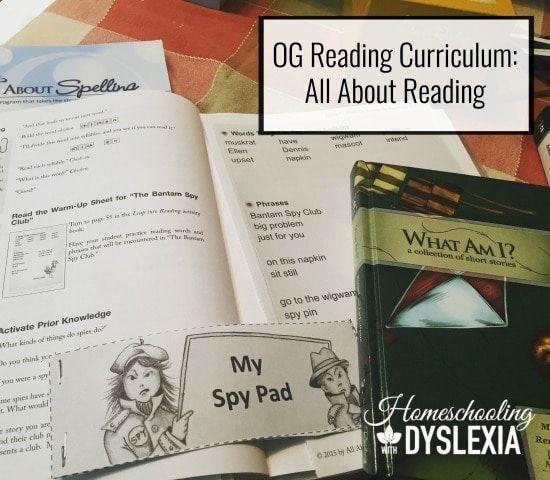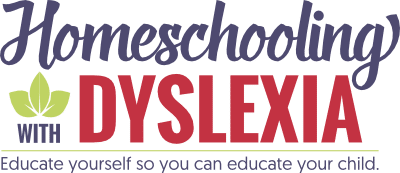
If you prefer to listen to this post, click the player below:

Of all reading programs, Orton-Gillingham has the most research to support its effectiveness with dyslexic learners. Over the course of our 20-year journey teaching kids with dyslexia to read, learning about and teaching with the Orton-Gillingham method has made the biggest impact on our kids reading.
Several years ago I became a certified OG dyslexia tutor to increase my confidence while homeschooling my own kids with dyslexia. I learned a lot during my training, but one of the things that I came away with was a better way to organize my reading lessons. This post will share how the OG approach recommends structuring lessons. At the end of the post, you can download a free OG reading lesson planner complete with instructions for how to use it.
Organizing an Orton-Gillingham Reading Lesson
The order of your lessons should be the same each session. A lesson plan should typically include the following five parts:
Part 1: Review
Review is critical to the success of any OG reading program. Kids with dyslexia need a LOT of review, therefore building a routine of review into every lesson is critical for making progress. Each of the drills and the review will take only a few minutes. We make review time fun by trying to go as quickly as possible with lots of smiles and laughter.
During review time, the student will practice the following:
Sight words. Review sight words until they can be read without prompting – a minimum of five times (over the course of 5 lessons). I even keep reviewing sight words until my kids can read them in their daily reading (the readers that come with our OG reading curriculum) with confidence.
Read this amazingly effective method for teaching sight words to kids with dyslexia.
Phonemic awareness. Many kids with dyslexia lack the foundational skill of phonemic awareness; being able to hear, identify and manipulate the individual sounds in words. Separating the spoken word “cat” into three distinct phonemes, /k/, /a/, and /t/, requires phonemic awareness.
Read this for ideas and resources for teaching phonemic awareness.
Visual drills. Use flash cards with graphemes (letters and groups of letters) and have your child say the phonemes (sounds made by graphemes). So for example, a flashcard has the grapheme ‘ee’ and your child says the long sound of ‘e’.
The purpose of the Visual Drill is to build automaticity (rapid naming) for matching graphemes to their phonemes. This is a very important skill for a student to be able to learn how to read (decode) words efficiently and effectively. Your child needs to be able to rapidly recall the phonemes for the graphemes in a word to be able to read (decode) the word fluently (with automaticity).
Use graphemes your child knows but needs to build fluency with and any new graphemes being taught. Put them in random order in your deck and review daily.
Auditory drills. Speak the individual phonemes (sounds) your child needs to practice. Your child repeats the sound and then writes the corresponding grapheme (letter or letters) on paper, a salt tray or on a dry erase board.
The purpose of the Auditory Drill is to build automaticity (rapid naming) for matching phonemes (sounds made by graphemes) to their graphemes (letters or groups of letters). This is a very important skill for a student to be able to learn how to spell words efficiently and effectively. The student needs to be able to rapidly recall the graphemes for the phonemes in a word to be able to spell (encode) the word fluently.

Blending drill. The purpose of the Blending Drill is to put into practice the skills they have gained from the visual drill. In the visual and auditory drills, your child worked on one grapheme to one phoneme or one phoneme to one grapheme. In the Blending Drill, they will work with two or more graphemes that they blend together into a word or syllable. The primary purpose of this drill is to learn how to blend phonemes together, not just to read a word.
We use the green word cards from All About Reading for our blending drills. We also love the Let’s Read series from Educators Publishing Service for daily blending drills. Have your kids read one 2-page spread three times in a row to build fluency.
Watch this short video clip of my 6-year old practicing reading fluency with Let’s Read.
Concept review. Review the main concept or concepts from the previous lesson. Use materials provided with your OG-based program such as letter tiles, flashcards and fluency sheets or games for this review. Use your Lesson Planner Sheet after each reading lesson to make notes of what concepts will need review in the next lesson. It is not uncommon for us to review new concepts for 3-4 lessons, especially in the younger years.

Part 2: Introduction of New Material
In this section, the student will be learning the next new concepts in their OG-based reading program. This may include new grapheme-phoneme correspondences, syllable types, syllabication rules, spelling rules, word patterns or other items. Follow your OG-based curriculum sequence for which material to introduce next.
This should include as much multi-sensory instruction as possible including guided instruction using letter tiles. Make notes on your lesson planner of what parts of the lesson you were able to cover, what you’ll do for the next lesson, and areas covered that need more review.
Part 3: Reading
In this section, the student should be practicing at the individual word level and with stories, or connected text. Controlled text, reading materials that only include words using the rules your child has already learned, should be used as much as possible. This will give him or her the opportunity to apply the decoding skills on words, sentences and running text that they have been learning.
Before reading running text (sentences and paragraphs) you should have your child practice any words that contain concepts or rules that the student is learning, but may be challenging for the student. This list should be created before the lesson.
The All About Reading program has warm up pages for each short story the child will read during his or her lesson. These prep sheets help struggling readers to feel a sense of confidence in their reading that is extremely motivating.
The reading material should provide a little challenge for the student, but not cause frustration. The student should be able to independently decode at least 95% of the material or they will struggle too much to be able to develop fluency.
For ideas on how to improve reading fluency, read this post.
Part 4: Spelling and Writing Dictation
In this section, your child will be learning and reviewing or practicing phoneme (sound) to grapheme (letter(s) conversion, syllables and syllabication, and spelling rules. They will practice words, phrases, and sentences. Follow your OG-based reading and spelling program for what and how to teach.
Part 5: Other Material
This section can include anything that the student is ready to learn that is not covered in the areas above. What is covered in this section will be dependent on the age and level of the student.
Some examples:
Reading out loud. Read out loud material that is too difficult for them to read independently, but is at their intellectual level. This offers the opportunity to help the student to continue to develop their higher order thinking skills with written material, practice visualizing and verbalizing, identifying new vocabulary, etc.
Learn new vocabulary words.
Learn grammar. Practice punctuation, grammar, sentence structure, paragraph skills, expository writing, etc.
Learn cursive (if appropriate for the student) See this post for how and why we teach cursive to our kids with dyslexia.
Take Notes!
Always take notes during and after the lesson to track where your child is showing increased skills and where they are having challenges. This is very important for preparing the next lesson. For reading lessons to be successful, they need to reinforce material previously taught, be sequential and incremental.
Also, always get feedback from your child during and at the end of the lesson. They will give you insight into what they are learning and it helps them to become more aware of what they are learning.
MY FAVORITE ORTON-GILLINGHAM RESOURCES
Programs with phonemic awareness exercises:
Logic of English Foundations A, B, C and D
Barton Reading and Spelling Level 1
Blending Drill Work
Orton-Gillingham Reading Programs to use at Home:
All About Reading and Spelling : Read my Review or Purchase
Logic of English : Read my Review or Purchase
Reading Horizons at Home : Read my Review or Purchase
Cursive Writing Curriculum
Organize Your OG Reading Lessons With a FREE Printable Lesson Planner
It is my goal to equip you to better teach your kids with dyslexia. You should have some kind of reading lesson planner to keep track of what you have covered and what your child still needs to work on. Download the planner I use (below) or create your own planner to organize what you are teaching.
FREE OG Reading Lesson Planner
Download and print to use at home!







It turns out that my son doesn’t have dyslexia, but some other form of visual processing disorder. We have been doing All About Reading and Spelling and when he got tested he knew the sounds and how to put them together but had a hard time reading due to adding or subtracting or substituting words like horse for pony even when there were no pictures.
Do you have any suggestions that will help him read better, even though this is a dyslexic site.
Hi, by reading your illustration I presumed his concepts to be built upon. He must be aware of grapheme phoneme relationship. Since he shows difficulty by adding, subtracting and substitute words… You start to work with base word and build up with prefix, suffix,make him understand entomology of the word!
Hello.my son is dislexia and I’m homeschooling but English is my second language he is between 1 and 2grade.so could you tell me what I need for reading i mean all the packages or curriculum he need with the interactive stuff..thank you could you do a discount …i will be a faithfully buyer for the rest of the grade…
I am working as a special education officer and i have learnt a lot from material. I am staying in Southern-Africa Lesotho country, and i would like to have the materials and books as to help parents and teachers with dyslexias children. How to get them?
Have been homeschooling my grandson who has dyslexia. He can’t get a high school diploma in Florida , he is fifteen . He is a super kid!!, Public school didn’t help him at all. A diploma will give him better job opportunities. Any help to achieve this will be appreciated. Thank you.
I would contact Decoding Dyslexia in Florida. Here is their web site. I’m not sure why he isn’t able to get a diploma. Is it because of homeschooling? If so, you may want to contact Homeschool Legal Defense as well.
I wasn’t able to download the lesson plan format that you had offered. Can you help me out?
Thanks,
AnnieB
Hi Annie. I emailed you!
I couldn’t download planner.
I have just learned of the curriculum for homeschooling children with dyslexia it is Time4learning. Do you have a review or an opinion on this program?
Hi Leslie,
I have used T4L in the past. It does help kids be independent because many of the lessons are video based. Some kids love it, some don’t.
I have been able to successfully download the lesson plan. God bless you abundantly.
I sent my email, but did not get the lesson planner. Can you please send it my way? Thank you!
Thanks for letting me know. I just emailed it!
The content of your post is really informative. I am interested in receiving the sample planner. Thank you 🙂
Good day, i have a 17yr old teenager in college doing IT, he loves IT but really struggling. we reside in Centurion_Gauteng in South Africa. what would you recommend that we do.
your assistance will be appreciated.
Regards
I’m not familiar with dyslexia support in South Africa but here in the US, there are student services offices on campus that are there to help kids who are struggling for any reason. Ask about that and go in to see if they provide testing or other help for him.
Hi,
How much time do you usually spend with your child to go through the entire recommended lesson plan?
I was wondering if I could have a copy of the planner
Please send me a copy of the free printable planner. Thank you!! I love your resources!